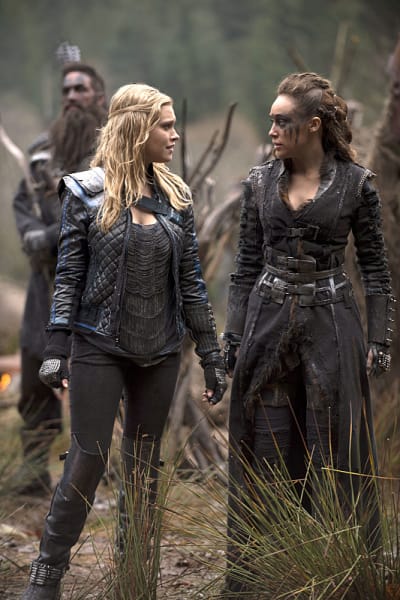LGBTQ+ Tropes on TV Need to Stop
 Inga Parkel
at
.
Updated at
.
Inga Parkel
at
.
Updated at
.
Just about every TV show wants to claim an LGBTQ+ character. Whether it is to fill a quota or simply to appeal to a wider audience.
Everybody wants to get represented in the media; however, the representation continues to appear with significant limitations.
Not to say that every show is stereotypically portraying LGBTQ+ characters, but the fact that these tropes are still used at all is especially problematic.
Throwing in a character who simply states they are gay, yet has no real storyline, is certainly not a proper representation, and unfortunately, that's the average most LGBTQ+ characters receive.
Related: Why We Need More Diverse Lesbian Representation on TV
A majority of the time, LGBTQ+ characters are given pieces of a storyline and generally fade into the background of the main plot. They're given a cliche character and don't seem to affect the progression of the storyline.
Providing true diversity is one thing, but only offering the illusion of diversity is another.
There's a major difference between TV shows that claim to have a diverse cast only for posters or previews and TV shows that offer genuine and in-depth storylines for their diverse characters.
If writers and producers are choosing to include an LGBTQ+ character in their show, they should provide more than a face and the anticipated. Otherwise, the character may as well be left out.
A trope is a term used in entertainment for an excessively used image or theme and are often associated negatively due to their overuse.
For reference, here are some of the most commonly used LGBTQ+ tropes on TV explained with respective examples.
Man-hating lesbian:
Lesbians whose main mission is to take down the patriarchy because all men are evil and worthless.
That happens to be a typical representation of most lesbians on shows despite this being an accurate representation of women in general, especially in this particular political climate.
Related: 13 Actors Who Saw the Other Side of Their Sexuality
Examples include Casey Ford from 13 Reasons Why, Jenny Schecter from The L Word, and Anya Jenkins from Buffy the Vampire Slayer.
Angry closeted jock:
Self-hating characters who choose to take out their repressive behaviors typically on those they actually have feelings for or those they envy.
They are mad at the world, and usually, we receive very little insight into their background or their psyche. It's not enough for us to truly feel sympathetic or understanding of them.
Examples include Dave Karofsky from Glee, Monty De la Cruz from 13 Reasons Why, and Paige McCullers from Pretty Little Liars.
Paige is a strong portrayal of a character who initially began as a trope, but evolved into much more than that.
The writers gave her a dynamic storyline through her romance with Emily. It was quite favorable that they turned the trope on its head and created a female version.
The Gay best friend:
The best friend of the main leading lady who usually provides her with fashion advice and boy support. He depicts the belief that men and women can never be platonic friends unless the guy is gay.
Often, he's stripped of his personality and is seen as a crutch for the lead as well as a place for a bulk of the humor to be placed.
Examples include Curt Hummel from Glee, Jack McFarland from Will & Grace, and Stanford Blatch from Sex and the City.
A simple solution to combatting these typical tropes is simply expanding them until they are no longer confined to a cliched box.
Related: 17 Shows that Aged like Fine Wine
It's ok if the character initially begins from one of these tropes, but keeping them stuck is the greatest issue.
They need more depth and not just a static characterization that doesn't evolve realistically.
The best characters are those who accurately depict humanity. So why can't that idea apply to LGBTQ+ characters as well?
While there's still much that needs to be paved in the way of diversity beyond sexual orientation, all we can do is hope for writers and producers to open their minds or at least for fresh perspectives to step into these production roles.
The issue is that most screenwriters and producers in Hollywood are afraid to create noise or stray from the norm.
Since success is based on ratings and viewership they don't want to lose those by creating shows that aren't representative of the majority.
However, if they want to keep up with the times, they should look at the changing tide in younger generations.
We're diverse and we want to see diversity on the screen.
A couple of TV shows that deserve praise for doing their part in changing the tides of Hollywood and their troublesome tropes are Euphoria and Grey's Anatomy.
Related: Enjoy UNLIMITED Acces to thousands of Movies and TV shows with Amazon Prime Video
Let's hope more follow suit! Batwoman, we have high hopes, please don't disappoint.
Don't forget to take your thoughts to the comments.
Let us know if you agree or disagree! Also, list any TV shows and characters you feel do the LGBTQ+ community justice.
I'm sure we can all benefit from it.
Inga Parkel was a staff writer for TV Fanatic. She left the organization in June 2020.












